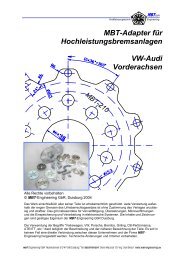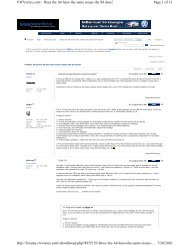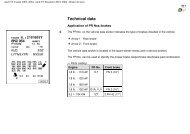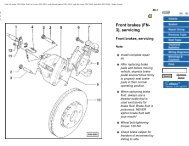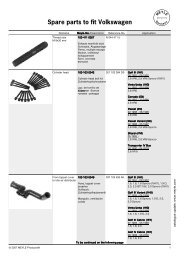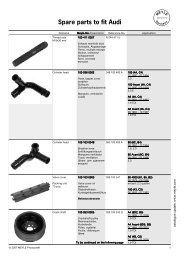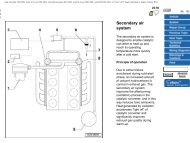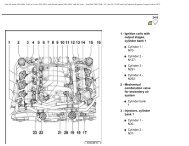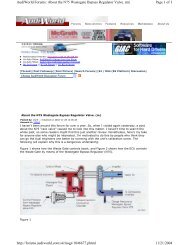VW MKII A2 MK2 Golf Jetta Fox Service Manual - VAGLinks.com
VW MKII A2 MK2 Golf Jetta Fox Service Manual - VAGLinks.com
VW MKII A2 MK2 Golf Jetta Fox Service Manual - VAGLinks.com
Create successful ePaper yourself
Turn your PDF publications into a flip-book with our unique Google optimized e-Paper software.
4.5 Two lengths of metal used to lock<br />
camshaft sprocket<br />
4 Camshaft - removal<br />
3<br />
1 Unscrew the nuts and bolts from the valve<br />
cover and remove the cover together with the<br />
gasket and reinforcement strips.<br />
2 Turn the engine until the indentation in the<br />
camshaft sprocket appears in the TDC hole in<br />
the timing cover and the notch in the crankshaft<br />
pulley is aligned with the TDC pointer on the<br />
front of the oil pump. Now turn the crankshaft<br />
one quarter of a turn anti-clockwise so that<br />
none of the pistons are at TDC.<br />
3 Unbolt and remove the timing cover, noting<br />
that the dipstick tube and earth lead are fitted<br />
to the upper bolts. On some later 1.3 litre<br />
models, it is necessary to remove the<br />
crankshaft pulley to remove the lower timing<br />
belt cover.<br />
4 Loosen the coolant pump retaining bolts,<br />
then turn the pump body clockwise to release<br />
the tension from the timing belt. Remove the<br />
timing belt from the camshaft sprocket.<br />
5 Devise a method to prevent the camshaft<br />
turning and remove the sprocket bolt (see<br />
illustration). Remove the camshaft sprocket<br />
and where applicable, the Woodruff key.<br />
6 The camshaft bearing caps must be refitted<br />
in their original locations and the same way<br />
round. They are usually numbered but mark<br />
them if necessary, to ensure correct refitting.<br />
7 Remove bearing caps Nos 5, 1 and 3, in<br />
that order. Now undo the nuts holding 2 and 4<br />
in a diagonal pattern and the camshaft will lift<br />
them up as the pressure of the valve springs<br />
is exerted. When they are free, lift the caps<br />
off.<br />
8 If the caps are stuck, give them a sharp tap<br />
with a soft-faced mallet to loosen them. Do<br />
not try to lever them off with a screwdriver.<br />
9 Lift out the camshaft <strong>com</strong>plete with the oil<br />
seal.<br />
5 Cylinder head - dismantling<br />
and overhaul 3<br />
Caution: If new tappets are fitted, the<br />
engine must not be started after fitting for<br />
approximately 30 minutes, or the valves<br />
will strike the pistons.<br />
Cylinder head<br />
1 If the valve seats are badly pitted or eroded<br />
they can be reworked but this is a specialist<br />
5.4 Removing an hydraulic bucket tappet 5.10 Removing valve spring upper seat<br />
Engine repair procedures - 1.05 and 1.3 litre post August 1985 2B•3<br />
job best left to a <strong>VW</strong> dealer or engine overhaul<br />
specialist.<br />
2 Similarly, if the head is warped, its surfaces<br />
can be skimmed, again by specialist<br />
engineers.<br />
3 If it is found that there are cracks from the<br />
valve seats or valve seat inserts to the spark<br />
plug threads, the cylinder head may still be<br />
serviceable. Consult your <strong>VW</strong> dealer for<br />
advice.<br />
Hydraulic bucket tappets<br />
4 With the camshaft removed, lift out the<br />
tappets one by one, ensuring that they are<br />
kept in their correct order and can be returned<br />
to their original bores (see illustration).<br />
5 Place them, cam contact surface down, on<br />
a clean sheet of paper as they are removed.<br />
6 Inspect the tappets for wear (indicated by<br />
ridging on the clean surface), pitting and<br />
cracks.<br />
7 Tappets cannot be repaired and if worn,<br />
must be renewed.<br />
8 Before fitting the tappets, lubricate all parts<br />
liberally with clean engine oil and slip each<br />
tappet back into its original bore.<br />
Valves<br />
9 With the camshaft and tappets removed,<br />
use a valve spring <strong>com</strong>pressor with a deep<br />
reach to <strong>com</strong>press the valve springs. Remove<br />
the two cotters and release the <strong>com</strong>pressor<br />
and springs.<br />
10 Lift out the upper spring seat (see<br />
illustration).<br />
11 Remove the outer and inner valve springs<br />
(see illustrations).<br />
12 Lift out the valve (see illustration).<br />
13 The valves should be inspected as<br />
described in Part A of this Chapter, Section<br />
11.<br />
14 Valves must be renewed if they are worn<br />
and be ground in the normal manner.<br />
15 If possible, check the valve spring lengths<br />
against new ones. Renew the whole set if any<br />
are too short.<br />
16 Refitting is a reversal of removal.<br />
Valve stem oil seals<br />
17 The valve stem oil seals should be<br />
renewed whenever the valves are removed,<br />
by prising them from the ends of the valve<br />
guides (see illustration).<br />
5.11a Removing an outer valve spring 5.11b Removing an inner valve spring 5.12 Removing a valve<br />
1081 <strong>VW</strong> <strong>Golf</strong> & <strong>Jetta</strong><br />
2B



